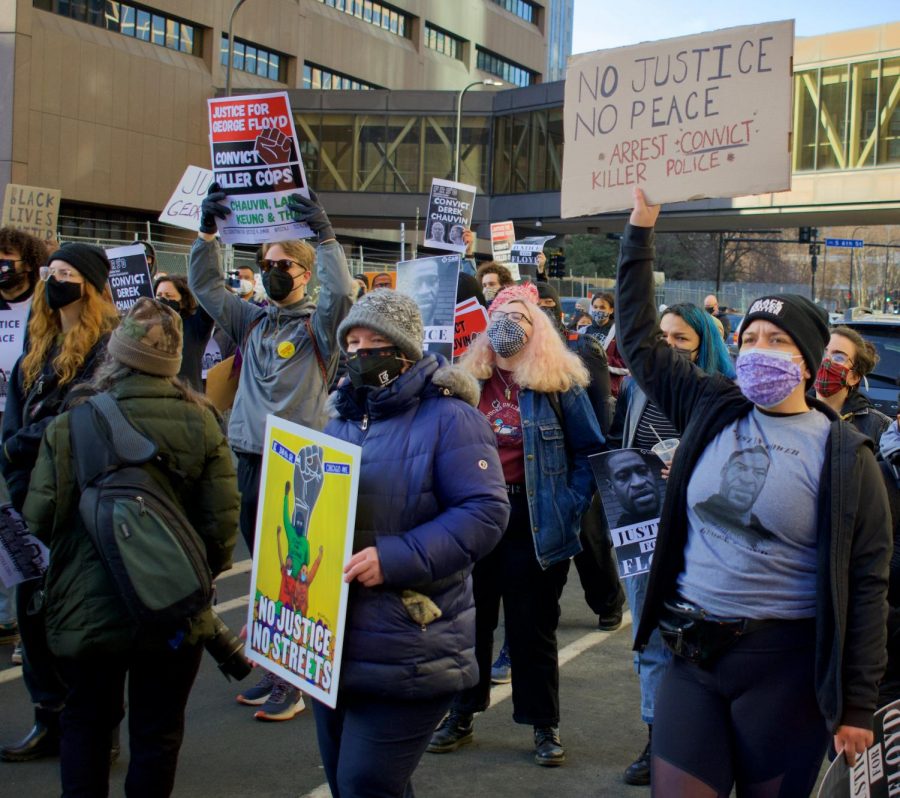For the rest of the world peering into Minneapolis, it appears the recent groundswell of support for Black lives this week is focused on George Floyd and the conviction of Derek Chauvin. But activist groups have been out for years protesting and organizing.
This drive for justice was evident on Monday, as hundreds of people gathered outside the Hennepin County Government Center demanding Chauvin be found guilty on the charge of murdering George Floyd.
The first day out
The protest started outside the government building with mirrors that had “Reflect” written across them in red paint and other colorful signs. It started off with a group barely taking up half a block, but by 11 a.m demonstrators had enough people to block off multiple streets at a time.
People marched down streets in the area, always keeping a speaker at the mic. Across the protest, community members showed their support through chants and conversation, sending an upbeat feel through the crowd.
“Everyone came together for the same cause. It gives you a little bit of optimism with all the stuff that’s going on,” said Mackenna Savage, a local protester.
Along with optimism, the crowd felt “angry but looking to move forward,” Savage said. Amber Heider, a University philosophy student, stood outside the government building waiting for the protest to start by herself, opting to show up as a single person, rather than with a group. She skipped class — and a test — to show support for the coalitions and “hold police accountable.”
The protests centered around the conviction of Chauvin but also demanded changes in policing. More than 20 coalitions organized the event, including the University of Minnesota chapter of Students for a Democratic Society.
“We want justice. We want police accountability,” said Sam Martinez, an organizer from the Twin Cities Coalition 4 Justice 4 Jamar. “In particular, we’re looking for community control of the police, because we got to stop these murders before they happen.”
When protesters returned to the front of the government building, they found mirrors smashed purposely by organizers lining the street, covered in fake blood, with bruised flowers tossed around the display. The mirrors, instructing their users to “reflect,” were meant to force the viewer to see themself in the “bloody” broken mirror.
Over eight months of activism
For some organizers, Monday was part of months or sometimes years of advocating against police brutality and for other social justice issues.
The run-up to the trial this week has been filled with events. The various coalitions have proposed legislation for police reform, such as ending qualified immunity for police officers and ending police-only responses to mental health crises. On Sunday, Families Supporting Families Against Police Violence held a protest at the governor’s mansion in St. Paul.
Organizers have been increasingly urging crowds to focus on the larger context involved in their calls for justice. This includes remembering individuals who have been victimized or killed by the police across Minnesota, as well as the need for comprehensive legislation, organizers say.
Zaynab Mohamed, a community advocacy manager for the Council on American-Islamic Relations (CAIR), said activists should continue looking at the bigger picture: pressuring politicians to implement policies such as the end of qualified immunity, increased accountability measures and community oversight of the police.
“It’s the first day of work,” she said. “We’ve been waiting and marching all summer, and we want to see conviction. We’re all here for George Floyd. We’re also here for every single life that’s been lost in the hands of the police and the state of Minnesota.”
Several community members who have been protesting consistently since May of last year have already begun learning from the George Floyd protests this past summer. One speaker mocked the arrangement of fences surrounding the government center, saying, “I ain’t stepping into no fucking cage.”
Other demonstrators and support organizations say they have needed to be more diligent in their de-escalation and first aid training, as well as increased vigilance regarding police tactics. Several group members from nonviolence groups and street medics watched over the demonstration on Monday in case they were needed for de-escalation in the crowd.
Street medics offered aid to injured protesters this summer, and medic Kalaya’an Mendoza, the director of U.S. programs at the Nonviolent Peace Force, said his group and others intend to continue providing all the support they can in the coming weeks.
“What we’ve seen in the last year, is that communities are the ones that keep us safe,” he said. “As unarmed civilian protectors we’re charged with doing what we can to keep all unarmed civilians safe.”
Activists have also been calling for more support between communities of color, particularly between the Black, Asian and Indigenous communities.
First-year youth studies major Jalisa Sang said it was powerful to be among other people of color fighting for the same cause and looks forward to returning to more protests.
“Seeing a bunch of other women of color and BIPOC people together makes it a really powerful alliance,” Sang said. “We’re here to show up for other BIPOC people.”




















CapnRusty
Mar 10, 2021 at 4:01 pm
“This drive for justice . . . hundreds of people . . . demanding Chauvin be found guilty.”
By that standard, a lynching constitutes “justice.” Obviously, the students in this mob are too un-educated to realize that.
Meat Eater
Mar 10, 2021 at 3:55 pm
“hundreds of activists ” the Metro area has well over 3 million residents, I have an idea for a news article: millions of people in Mpls/StP went about their business, letting the legal system do its job